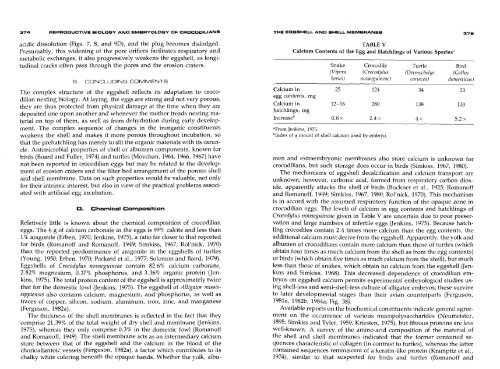Reproductive Biology and Embryology of the ... - Seaturtle.org
Reproductive Biology and Embryology of the ... - Seaturtle.org
Reproductive Biology and Embryology of the ... - Seaturtle.org
You also want an ePaper? Increase the reach of your titles
YUMPU automatically turns print PDFs into web optimized ePapers that Google loves.
374 REPROOUCTIVE BIOLOGY ANO EMBRYOLOGY OF CROCOOILIANS<br />
THE EGGSHELL ANO SHELL MEMBRANES<br />
375<br />
acidic dissolution (Figs. 7, 8, <strong>and</strong> 90), <strong>and</strong> <strong>the</strong> plug becomes dislodged.<br />
Presumably, this widening <strong>of</strong> <strong>the</strong> pore orifices facilitates respiratory <strong>and</strong><br />
metabolic exchanges; it also progressively weakens <strong>the</strong> eggshell, as longitudinal<br />
cracks <strong>of</strong>ten pass through <strong>the</strong> pores <strong>and</strong> <strong>the</strong> erosion craters.<br />
8. CONCLUDING COMMENTS<br />
The complex structure <strong>of</strong> <strong>the</strong> eggshell reflects its adaptation to crocodilian<br />
nesting biology. At laying, <strong>the</strong> eggs are strong <strong>and</strong> not very porous;<br />
<strong>the</strong>y are thus protected from physical damage at <strong>the</strong> time when <strong>the</strong>y are<br />
deposited one upon ano<strong>the</strong>r <strong>and</strong> whenever <strong>the</strong> mo<strong>the</strong>r treads nesting material<br />
on top <strong>of</strong> <strong>the</strong>m, as well as from dehydration during early development.<br />
The complex sequence <strong>of</strong> changes in <strong>the</strong> in<strong>org</strong>anic constituents<br />
weakens <strong>the</strong> shell <strong>and</strong> makes it more porous throughout incubation, so<br />
that <strong>the</strong> prehatchling has merely to slit <strong>the</strong> <strong>org</strong>anic materials with its caruncle.<br />
Antimicrobial properties <strong>of</strong> shell or albumen components, known for<br />
birds (Board <strong>and</strong> Fuller, 1974) <strong>and</strong> turtles (Movchan, 1964, 1966, 1967) have<br />
not been reported in crocodilian eggs but may be related to <strong>the</strong> development<br />
<strong>of</strong> erosion craters <strong>and</strong> <strong>the</strong> filter bed arrangement <strong>of</strong> <strong>the</strong> porous shell<br />
<strong>and</strong> shell membrane. Data on such properties would be valuable, not only<br />
for <strong>the</strong>ir intrinsic interest, but also in view <strong>of</strong> <strong>the</strong> practical problems associated<br />
with artificial egg incubation.<br />
C. Chemical Composition<br />
Relatively little is known about <strong>the</strong> chemical composition <strong>of</strong> crocodilian<br />
eggs. The 6 g <strong>of</strong> calcium carbonate in <strong>the</strong> eggs is 99% calcite <strong>and</strong> less than<br />
1% aragonite (Erben, 1970; Jenkins, 1975), a ratio far closer to that reported<br />
for birds (Roman<strong>of</strong>f <strong>and</strong> Roman<strong>of</strong>f, 1949; Simkiss, 1967; Rol'nick, 1970)<br />
than <strong>the</strong> reported predominance <strong>of</strong> aragonite in <strong>the</strong> eggshells <strong>of</strong> turtles<br />
(Young, 1950; Erben, 1970; Packard et al., 1977; Solomon <strong>and</strong> Baird, 1979).<br />
Eggshells <strong>of</strong> Crocodylus novaeguineae contain 82.6% calcium carbonate,<br />
2.82% magnesium, 0.37% phosphorus, <strong>and</strong> 3.36% <strong>org</strong>anic protein (Jenkins,<br />
1975). The total protein content <strong>of</strong> <strong>the</strong> eggshell is approximately twice<br />
that for <strong>the</strong> domestic fowl (Jenkins, 1975). The eggshell <strong>of</strong> Alligator mississippiensis<br />
also contains calcium, magnesium, <strong>and</strong> phosphorus, as well as<br />
traces <strong>of</strong> copper, silicon, sodium, aluminum, iron, zinc, <strong>and</strong> manganese<br />
(Ferguson, 1982a).<br />
The thickness <strong>of</strong> <strong>the</strong> shell membranes is reflected in <strong>the</strong> fact that <strong>the</strong>y<br />
comprise 21.39% <strong>of</strong> <strong>the</strong> total weight <strong>of</strong> dry shell <strong>and</strong> membrane (Jenkins,<br />
1975), whereas <strong>the</strong>y only comprise 0.3% in <strong>the</strong> domestic fowl (Roman<strong>of</strong>f<br />
<strong>and</strong> Roman<strong>of</strong>f, 1949). The shell membrane acts as an intermediary calcium<br />
store between that <strong>of</strong> <strong>the</strong> eggshell <strong>and</strong> <strong>the</strong> calcium in <strong>the</strong> blood <strong>of</strong> <strong>the</strong><br />
chorioallantoic vessels (Ferguson, 1982a), a factor which contributes to its<br />
chalky white coloring beneath <strong>the</strong> opaque b<strong>and</strong>s. Whe<strong>the</strong>r <strong>the</strong> yolk, albu-<br />
TABLE V<br />
Calcium Contents <strong>of</strong> <strong>the</strong> Egg <strong>and</strong> Hatchlings <strong>of</strong> Various Species"<br />
Snake Crocodile Turtle Bird<br />
(Vipera (Crocodylus (Dermocllelys (Gallus<br />
berus) nouaeguineae) coriacea) domesticus)<br />
Calcium in 25 124 34 23<br />
egg contents, mg<br />
Calcium in 12-16 280 138 120<br />
hatchlings, mg<br />
lncrease b 0.8x 2.4x 4x 5.2x<br />
"From Jenkins, 1975.<br />
blndex <strong>of</strong> a mount <strong>of</strong> shell calcium used by embryo.<br />
men <strong>and</strong> extraembryonic membranes also store calcium is unknown for<br />
crocodilians, but such storage does occur in birds (Simkiss, 1967, 1980).<br />
The mechanisms <strong>of</strong> eggshell decalcification <strong>and</strong> calcium transport are<br />
unknown; however, carbonic acid, formed from respiratory carbon dioxide,<br />
apparently attacks <strong>the</strong> shell <strong>of</strong> birds (Buckner et al., 1925; Roman<strong>of</strong>f<br />
<strong>and</strong> Roman<strong>of</strong>f, 1949; Simkiss, 1967, 1980; Rol'nick, 1970). This mechanism<br />
is in accord with <strong>the</strong> assumed respiratory function <strong>of</strong> <strong>the</strong> opaque zone in<br />
crocodilian eggs. The levels <strong>of</strong> calcium in egg contents <strong>and</strong> hatchlings <strong>of</strong><br />
Crocodylus novaeguineae given in Table V are uncertain due to poor preservation<br />
<strong>and</strong> large numbers <strong>of</strong> infertile eggs (Jenkins, 1975). Because hatchling<br />
crocodiles contain 2.4 times more calcium than <strong>the</strong> egg contents, <strong>the</strong><br />
additional calcium must derive from <strong>the</strong> eggshell. Apparently, <strong>the</strong> yolk <strong>and</strong><br />
albumen <strong>of</strong> crocodilians contain more calcium than those <strong>of</strong> turtles (which<br />
obtain four times as much calcium from <strong>the</strong> shell as from <strong>the</strong> egg contents)<br />
or birds (which obtain five times as much calcium from <strong>the</strong> shell), but much<br />
less than those <strong>of</strong> snakes, which obtain no calcium from <strong>the</strong> eggshell (Jenkins<br />
<strong>and</strong> Simkiss, 1968). This decreased dependence <strong>of</strong> crocodilian embryos<br />
on eggshell calcium permits experimental embryological studies using<br />
shell-less <strong>and</strong> semi-sheIl-less culture <strong>of</strong> alligator embryos; <strong>the</strong>se survive<br />
to later developmental stages than <strong>the</strong>ir avian counterparts (Ferguson,<br />
1981a, 1982b, 1984a; Fig. 38).<br />
Available reports on <strong>the</strong> biochemical constituents indicate general agreement<br />
on <strong>the</strong> occurrence <strong>of</strong> various mucopolysaccharides (Neumeister,<br />
1895; Simkiss <strong>and</strong> Tyler, 1959; Kriesten, 1975), but fibrous proteins are less<br />
well-known. A survey <strong>of</strong> <strong>the</strong> amino-acid composition <strong>of</strong> <strong>the</strong> material <strong>of</strong><br />
<strong>the</strong> shell <strong>and</strong> shell membranes indicated that <strong>the</strong> former contained sequences<br />
characteristic <strong>of</strong> collagen (in contrast to turtles), whereas <strong>the</strong> latter<br />
contained sequences reminiscent <strong>of</strong> a keratin-like protein (Kramptiz et al.,<br />
1974), similar to that suspected for birds <strong>and</strong> turtles (Roman<strong>of</strong>f <strong>and</strong>
















